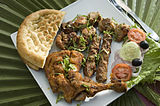Balti (food)/ja: Difference between revisions
Created page with "==参考資料== * 『カリークラブ・バルティカレー・クックブック』、ピアトカス、ロンドン — {{ISBN|0-7499-1214-6}} & {{ISBN|0-7499-1342-8}}(1993年) * 『モダン・バルティカレー』、上記をジョン・ブレイク・パブリッシングより再版、ロンドン(2006年) * 『パット・チャップマンズ・バルティ・バイブ..." |
Created page with "1990年代後半以降、イギリスのスーパーマーケットでは、様々な種類のプレパックのバルティ料理が店頭に並ぶようになり、バルティレストラン業界は、他の伝統的な南アジア料理やインド料理レストランと同様に、小売業界からの競争激化や顧客の好みの変化に直面している。" |
||
| (13 intermediate revisions by the same user not shown) | |||
| Line 1: | Line 1: | ||
<languages /> | <languages /> | ||
[[File:Balti gosht.jpg|thumb|「バルチ・ゴシュト」のラムバージョン]] | |||
[[File:Balti gosht.jpg|thumb| | |||
'''バルティ'''または'''バルティ・ゴシュト'''(ウルドゥー語: {{Nastaliq|بالٹی گوشت}}、ヒンディー語: बाल्टी गोश्त)は、「バルティボウル」と呼ばれる薄いプレス鋼製の[[Wok/ja|中華鍋]]で提供される[[curry/ja|カレー]]の一種である。この名前は、特定の材料や調理法に由来するのではなく、カレーを調理する金属製の器に由来している可能性がある。''バルティ''カレーは、[[Ghee/ja|ギー]]ではなく[[Vegetable oil/ja|植物油]]を使い、[[Stir frying/ja|炒め物]]のように強火で手早く調理され、骨なしの肉が使われる。この組み合わせは、一日中ゆっくり煮込む伝統的な一品料理のインドカレーとは大きく異なる。''バルティ''ソースは、[[garlic/ja|ニンニク]]と[[onion/ja|玉ねぎ]]をベースに、[[turmeric/ja|ターメリック]]や''[[garam masala/ja|ガラムマサラ]]''などのスパイスが使われる。 | |||
''バルティ・ゴシュト''は[[:en:North India|北インド]]や[[:en:Pakistan|パキスタン]]の一部、そしてイギリスなど世界各地で食べられている。イギリス版のバルティは1977年に[[:en:Birmingham|バーミンガム]]で開発された。 | |||
'' | |||
==起源、歴史、語源{{Anchor|Origin, history and etymology}}== | |||
==Origin, history and etymology== | |||
[[File:Balti Gosht.JPG|thumb|パキスタンの''バルティ・ゴシュト'']] | |||
食品としての''バルティ''は、[[:en:karahi|同地域]]のカラヒと同様に、調理される鋼鉄または鉄製の鍋にちなんで名付けられている。 | |||
この言葉は[[:en:Hindustani language|ヒンドゥスターニー語]]、[[:en:Odia language|オリヤー語]]、[[:en:Bengali language|ベンガル語]]に見られ、「バケツ」を意味する。この言葉は、バケツまたは手桶を意味するポルトガル語の''balde''に由来し、16世紀初頭のポルトガル人の航海事業を通じて[[:en:Indian subcontinent|インド亜大陸]]にもたらされた。この言葉は、おそらく[[:en:British Raj|イギリス領インド帝国]]時代に英語に入ったものと思われる。 | |||
[[:en:Pat Chapman (food writer)|フードライターのパット・チャップマン]]によると、この言葉の起源は[[:en:Kashmir|カシミール地方]]北部にある[[:en:Baltistan|バルティスタン]]地域に遡ることができるという。そこでは、中国の[[Wok/ja|中華鍋]]に似た[[Cast-iron cookware/ja|鋳鉄製の中華鍋]]が調理に使われている。バルティスタンは中国と国境を接している。彼の著書『[[:en:Curry Club Magazine|カリークラブ・バルティカレー・クックブック]]』の中で、チャップマンは次のように述べている。{{quote|バルティ鍋は、丸底で中華鍋のような重い鋳鉄製の鍋で、2つの取っ手がついている。...バルティ料理の起源は多岐にわたり、([[Sichuan cuisine/ja|四川料理]]の辛い料理に少し似た)中国料理や[[Tibetan cuisine/ja|チベット料理]]だけでなく、[[:en:Mirpur, Azad Kashmir|ミールプール人]]の祖先、[[:en:Mughlai cuisine|ムガル皇帝]]の[[:en:Mughal emperors|嗜好]]、[[Kashmiri cuisine/ja|カシミール]]の香り高いスパイス、そして山岳地帯の「冬の食べ物」にも負うところが大きい。|author=|title=|source=}} | |||
しかし、[[:en:Colleen Taylor Sen|コリーン・テイラー・セン]]は、バルティスタンで食べられている料理は''バルティ・ゴシュト''とは「似ていない」ため、''バルティ・ゴシュト''の起源は不明確であると述べている。そのため、この料理の名前は、''バルティ・ゴシュト''がヒンドゥスターニー語でバケツを意味する''baltī''に似た鍋で調理されるという事実に由来する可能性がある。 | |||
バーミンガムにおける''バルティ''料理の起源に関するもう一つの主張は、1977年にアディルズというレストランで初めて提供されたというものである。当時、このレストランは[[:en:Sparkbrook|スパークブルック]]のストーニー・レーンに位置していたが、しばらくして別の場所に店舗を移した後、現在はストーニー・レーンの元の場所に戻っている。 | |||
== バルティハウス{{Anchor|Balti houses}}== | |||
Balti houses | |||
[[File:Shops on Essex Street - Cafe Tandoori Balti and Rainbow Cars.jpg|thumb|バーミンガムのエセックス・ストリートにあるバルティ・レストラン]] | |||
[[File:Chicken Balti Bhuna.jpg|thumb|スコットランドのエディンバラの「バルティ」チキンとライス、ナン]] | |||
バーミンガムでは、''バルティ''を提供するレストランは「バルティハウス」として知られていることが多い。一部のバルティハウスでは、テーブルの天板にガラス板が置かれ、その下にメニューが挟まれている。バルティハウスでは、通常、テーブル全体でシェアできる大きな''カラック''の[[naan/ja|ナン]]が提供される。 | |||
バルティハウスは元々、バーミンガム市中心部の南にある[[:en:Sparkhill|スパークヒル]]と[[:en:Moseley|モーズリー]]を結ぶ幹線道路沿いやその裏手に集中していた。この地域は、レディプール・ロード、ストーニー・レーン、ストラトフォード・ロードで構成されており、今でも**「バルティ・トライアングル」**と呼ばれることがあり、バルティレストランが密集している。2005年7月28日、[[:en:Birmingham Tornado (UK)|竜巻]]がこのトライアングルの建物に甚大な被害をもたらし、多くのレストランが閉店を余儀なくされた。ほとんどの店は2006年初めまでに再開したが、2023年現在ではわずか4軒しか残っていない。 | |||
バルティハウスは現在、トライアングルを越えて広がり、バーミンガム南部、[[:en:Stirchley, West Midlands|スターチリー]]のパーショア・ロード沿いにも見られる。バーミンガム西部の[[:en:Stourbridge|ストゥールブリッジ]]近郊の[[:en:Lye, West Midlands|ライ]]は、「バルティ・マイル」として知られるようになり、ハイストリート沿いに12軒ものレストランが集中している。 | |||
この料理とその提供スタイルは1980年代に非常に人気を博し、1990年代にはその人気がさらに高まった。バルティレストランは[[:en:West Midlands (county)|ウェスト・ミッドランズ]]全体、そして[[:en:United Kingdom|イギリス]]の大部分に徐々にオープンしていった。イギリスの拡大したカレー市場は、現在年間40億ポンドの売り上げがあると言われている。 | |||
イギリス国外では、[[:en:Ireland|アイルランド]]や他の多くの英語圏の国々、特に[[:en:Australia|オーストラリア]]、[[:en:Canada|カナダ]]、[[:en:New Zealand|ニュージーランド]]にも少数のバルティハウスがある。 | |||
== | |||
*[[Pakistani cuisine]] | 1990年代後半以降、イギリスのスーパーマーケットでは、様々な種類のプレパックのバルティ料理が店頭に並ぶようになり、バルティレストラン業界は、他の伝統的な南アジア料理やインド料理レストランと同様に、小売業界からの競争激化や顧客の好みの変化に直面している。 | ||
*[[Chicken tikka masala]] | |||
==関連項目== | |||
*[[Pakistani cuisine/ja]] | |||
*[[Chicken tikka masala/ja]] | |||
==参考資料== | ==参考資料== | ||
Latest revision as of 08:39, 13 July 2025

バルティまたはバルティ・ゴシュト(ウルドゥー語: بالٹی گوشت、ヒンディー語: बाल्टी गोश्त)は、「バルティボウル」と呼ばれる薄いプレス鋼製の中華鍋で提供されるカレーの一種である。この名前は、特定の材料や調理法に由来するのではなく、カレーを調理する金属製の器に由来している可能性がある。バルティカレーは、ギーではなく植物油を使い、炒め物のように強火で手早く調理され、骨なしの肉が使われる。この組み合わせは、一日中ゆっくり煮込む伝統的な一品料理のインドカレーとは大きく異なる。バルティソースは、ニンニクと玉ねぎをベースに、ターメリックやガラムマサラなどのスパイスが使われる。
バルティ・ゴシュトは北インドやパキスタンの一部、そしてイギリスなど世界各地で食べられている。イギリス版のバルティは1977年にバーミンガムで開発された。
起源、歴史、語源

食品としてのバルティは、同地域のカラヒと同様に、調理される鋼鉄または鉄製の鍋にちなんで名付けられている。 この言葉はヒンドゥスターニー語、オリヤー語、ベンガル語に見られ、「バケツ」を意味する。この言葉は、バケツまたは手桶を意味するポルトガル語のbaldeに由来し、16世紀初頭のポルトガル人の航海事業を通じてインド亜大陸にもたらされた。この言葉は、おそらくイギリス領インド帝国時代に英語に入ったものと思われる。
フードライターのパット・チャップマンによると、この言葉の起源はカシミール地方北部にあるバルティスタン地域に遡ることができるという。そこでは、中国の中華鍋に似た鋳鉄製の中華鍋が調理に使われている。バルティスタンは中国と国境を接している。彼の著書『カリークラブ・バルティカレー・クックブック』の中で、チャップマンは次のように述べている。
バルティ鍋は、丸底で中華鍋のような重い鋳鉄製の鍋で、2つの取っ手がついている。...バルティ料理の起源は多岐にわたり、(四川料理の辛い料理に少し似た)中国料理やチベット料理だけでなく、ミールプール人の祖先、ムガル皇帝の嗜好、カシミールの香り高いスパイス、そして山岳地帯の「冬の食べ物」にも負うところが大きい。
しかし、コリーン・テイラー・センは、バルティスタンで食べられている料理はバルティ・ゴシュトとは「似ていない」ため、バルティ・ゴシュトの起源は不明確であると述べている。そのため、この料理の名前は、バルティ・ゴシュトがヒンドゥスターニー語でバケツを意味するbaltīに似た鍋で調理されるという事実に由来する可能性がある。
バーミンガムにおけるバルティ料理の起源に関するもう一つの主張は、1977年にアディルズというレストランで初めて提供されたというものである。当時、このレストランはスパークブルックのストーニー・レーンに位置していたが、しばらくして別の場所に店舗を移した後、現在はストーニー・レーンの元の場所に戻っている。
バルティハウス


バーミンガムでは、バルティを提供するレストランは「バルティハウス」として知られていることが多い。一部のバルティハウスでは、テーブルの天板にガラス板が置かれ、その下にメニューが挟まれている。バルティハウスでは、通常、テーブル全体でシェアできる大きなカラックのナンが提供される。
バルティハウスは元々、バーミンガム市中心部の南にあるスパークヒルとモーズリーを結ぶ幹線道路沿いやその裏手に集中していた。この地域は、レディプール・ロード、ストーニー・レーン、ストラトフォード・ロードで構成されており、今でも**「バルティ・トライアングル」**と呼ばれることがあり、バルティレストランが密集している。2005年7月28日、竜巻がこのトライアングルの建物に甚大な被害をもたらし、多くのレストランが閉店を余儀なくされた。ほとんどの店は2006年初めまでに再開したが、2023年現在ではわずか4軒しか残っていない。
バルティハウスは現在、トライアングルを越えて広がり、バーミンガム南部、スターチリーのパーショア・ロード沿いにも見られる。バーミンガム西部のストゥールブリッジ近郊のライは、「バルティ・マイル」として知られるようになり、ハイストリート沿いに12軒ものレストランが集中している。
この料理とその提供スタイルは1980年代に非常に人気を博し、1990年代にはその人気がさらに高まった。バルティレストランはウェスト・ミッドランズ全体、そしてイギリスの大部分に徐々にオープンしていった。イギリスの拡大したカレー市場は、現在年間40億ポンドの売り上げがあると言われている。
イギリス国外では、アイルランドや他の多くの英語圏の国々、特にオーストラリア、カナダ、ニュージーランドにも少数のバルティハウスがある。
1990年代後半以降、イギリスのスーパーマーケットでは、様々な種類のプレパックのバルティ料理が店頭に並ぶようになり、バルティレストラン業界は、他の伝統的な南アジア料理やインド料理レストランと同様に、小売業界からの競争激化や顧客の好みの変化に直面している。
関連項目
参考資料
- 『カリークラブ・バルティカレー・クックブック』、ピアトカス、ロンドン — ISBN 0-7499-1214-6 & ISBN 0-7499-1342-8(1993年)
- 『モダン・バルティカレー』、上記をジョン・ブレイク・パブリッシングより再版、ロンドン(2006年)
- 『パット・チャップマンズ・バルティ・バイブル』、ホッダー&スタウトン、ロンドン — ISBN 0-340-72858-2 & ISBN 0-340-72859-0(1998年)
- 『2009年 コブラ グッド・カリー・ガイド』、ジョン・ブレイク・パブリッシング、ロンドン — ISBN 1-84454-311-0
外部リンク
| この記事は、クリエイティブ・コモンズ・表示・継承ライセンス3.0のもとで公表されたウィキペディアの項目Balti (food)(12 April 2025, at 20:21編集記事参照)を翻訳して二次利用しています。 |
